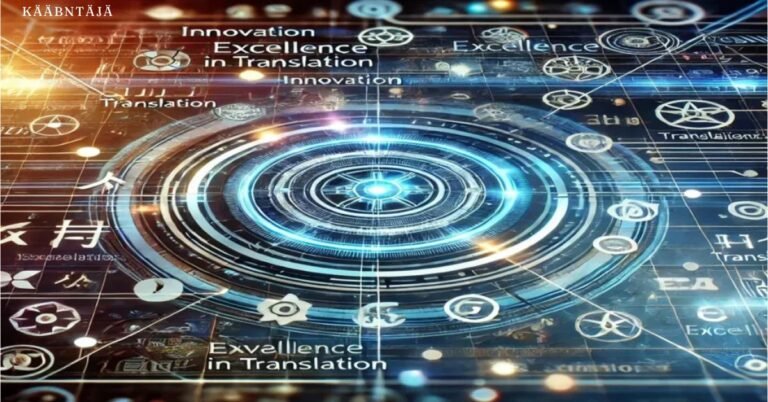The term kääntäjä, originating from Finnish, translates to “translator” in English. This simple word encapsulates a vast and dynamic field of translation, spanning both human and machine efforts to break language barriers in an increasingly globalized world. From facilitating international business communications to empowering travelers in foreign lands, kääntäjä serves as a crucial tool in our interconnected era.
In this article, we dive deep into the world of kääntäjä, exploring its different forms, uses, and significance. We’ll also provide a detailed comparison of popular tools, examine the challenges of machine translation, and discuss how this technology is shaping the future of communication.
What Is a Kääntäjä?
At its core, a kääntäjä refers to any tool or individual that translates content from one language to another. While human translators have been the gold standard for centuries, the advent of technology has brought about machine-based solutions that can perform translations in seconds.
Today’s kääntäjät are divided into two main categories:
Human Translators
These are professional linguists with a deep understanding of grammar, culture, and context. Human translators are indispensable for projects that require high precision, such as legal contracts, medical documents, or creative works like novels.
Machine Translators
These are software solutions, such as Google Translate or DeepL, that leverage algorithms and artificial intelligence to provide instant translations. They’re ideal for quick, informal translations but may lack the nuance and accuracy of human expertise.
The Evolution of Translation Technology
Translation technology has come a long way since the first primitive tools. Here’s a brief timeline of its evolution:
- Early Dictionaries: In the pre-digital era, dictionaries were the primary resource for translating words and phrases.
- 1980s-1990s: The first computerized translation systems emerged, relying on rule-based algorithms to convert text.
- 2000s: Machine translation began incorporating statistical methods, improving accuracy by analyzing vast datasets of bilingual texts.
- 2010s: Neural machine translation (NMT) revolutionized the field, using AI to understand context and deliver more natural translations.
- Present Day: Tools like Google Translate and DeepL continue to refine their algorithms, offering features like voice translation, image-based translation, and real-time conversation support.
Popular Kääntäjät and Their Features
With so many translation tools available, it can be challenging to choose the right one. Here’s a detailed comparison of some of the most popular kääntäjät:
| Tool | Key Features | Best For | Limitations |
|---|---|---|---|
| Google Kääntäjä | Text, voice, and image translation; offline mode | Everyday use, travelers | Limited accuracy for complex text |
| DeepL Translator | Superior context and nuance understanding | Business documents, formal texts | Limited language support |
| Microsoft Translator | Real-time conversation translation, multi-device sync | Business meetings, casual use | Less accurate for niche terms |
| iTranslate | Voice translation, phrasebooks, offline support | Travelers, students | Subscription required for advanced features |
| Yandex Kääntäjä | Website translation, examples with synonyms | Casual users, online readers | Interface less intuitive |
Each tool has its strengths and weaknesses, making it essential to choose one based on your specific needs.
The Role of Kääntäjät in Everyday Life
Kääntäjät have seamlessly integrated into our daily routines, simplifying tasks and enabling new opportunities. Here are some common applications:
Travel and Tourism
Travelers often rely on translation tools to communicate with locals, understand menus, read signs, and navigate new environments. Features like offline mode and camera-based translation are especially valuable in areas with limited internet connectivity.
Education and Learning
Language learners use kääntäjät to practice vocabulary, understand foreign texts, and improve pronunciation. Tools like Google Translate offer audio playback, helping learners grasp correct pronunciations.
Business Communication
In an increasingly global economy, businesses depend on translation tools to communicate with international clients, partners, and employees. From translating emails to preparing multilingual marketing materials, kääntäjät are indispensable for global operations.
Cultural Exchange
Translation tools promote cultural understanding by making books, movies, and other media accessible to audiences worldwide. Machine translation has even enabled real-time subtitling for live events.
Challenges Faced by Machine Kääntäjät
While machine translators offer convenience and speed, they are far from perfect. Some common challenges include:
- Contextual Errors
Machine translators often struggle with idiomatic expressions, slang, and cultural nuances. For instance, a phrase like “break the ice” might be translated literally, leading to confusion. - Specialized Terminology
Fields like medicine, law, and engineering require precise terminology that machine translators may fail to deliver. Incorrect translations in these contexts can have serious consequences. - Syntax and Grammar
Complex sentence structures can trip up even the most advanced tools, resulting in awkward or nonsensical translations. - Bias in AI
Translation tools trained on biased datasets may perpetuate stereotypes or inaccuracies, highlighting the need for more inclusive training methods.
Tips for Effective Use of Kääntäjät
To get the most out of your kääntäjä, follow these best practices:
- Simplify Your Input: Use short, clear sentences to minimize errors in machine translation.
- Verify Critical Translations: For important documents, cross-check translations with multiple tools or consult a human translator.
- Leverage Additional Features: Take advantage of voice and image translation for tasks beyond text.
- Use the Feedback Option: Many tools allow users to suggest corrections, which helps improve future translations.
The Future of Kääntäjät
The future of translation technology is bright, with ongoing advancements in artificial intelligence and natural language processing. Here’s what we can expect in the coming years:
- Real-Time Multilingual Conversations
As voice translation improves, we may soon have devices capable of facilitating seamless conversations between speakers of different languages. - Increased Personalization
AI-driven kääntäjät could adapt to individual user preferences, delivering translations tailored to specific contexts or industries. - Integration with Wearable Devices
Smart glasses and other wearables may offer real-time subtitles for live conversations or translated overlays for signs and menus. - Greater Accessibility
Efforts are underway to make translation tools available in underserved languages, preserving linguistic diversity and fostering inclusivity.
An Ethical Perspective on Machine Translation
As kääntäjät become more advanced, ethical considerations come to the forefront. For example:
- Privacy Concerns: Users must be aware that some tools store translation data, potentially exposing sensitive information.
- Job Displacement: While machine translation enhances efficiency, it raises concerns about its impact on professional translators.
- Cultural Integrity: Ensuring that translations respect and accurately represent cultural contexts is crucial for fostering understanding and unity.
Final Thoughts on Kääntäjä
Whether you’re navigating a foreign city, closing an international business deal, or learning a new language, kääntäjä are invaluable tools for breaking down language barriers. While machine translation has its limitations, advancements in AI are bringing us closer to achieving seamless, accurate communication across languages.
As you explore the world of kääntäjät, remember to use these tools responsibly, valuing the rich diversity of languages and cultures they help us connect with.

